
Addison Emery Verrill was an American invertebrate zoologist, museum curator and university professor.

Caecum is a genus of minute sea snails, marine gastropod micromolluscs or micromollusks in the family Caecidae or blind shells.

Newtoniellidae is a family of minute sea snails, marine gastropod mollusks or micromollusks in the superfamily Triphoroidea. It contains the following subfamilies :
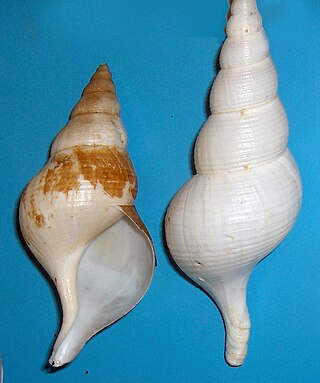
Colus is a genus of sea snails, marine gastropod mollusks in the family Colidae, the true whelks and the like.
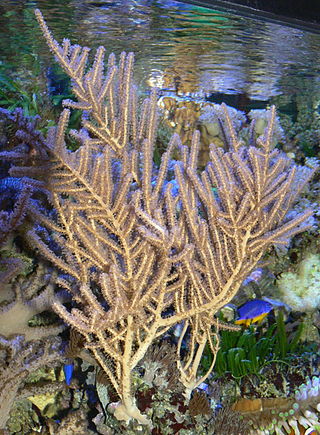
Holaxonia is a suborder of soft corals, a member of the phylum Cnidaria. Members of this suborder are sometimes known as gorgonians and include the sea blades, the sea fans, the sea rods and the sea whips. These soft corals are colonial, sessile organisms and are generally tree-like in structure. They do not have a hard skeleton composed of calcium carbonate but have a firm but pliable, central axial skeleton composed of a fibrous protein called gorgonin embedded in a tissue matrix, the coenenchyme. In some genera this is permeated with a calcareous substance in the form of fused spicules. Members of this suborder are characterized by having an unspiculated axis and often a soft, chambered central core. The polyps have eight-fold symmetry and in many species, especially in the families Gorgoniidae and Plexauridae, contain symbiotic photosynthetic algae called zooxanthellae. These soft corals are popular in salt water aquaria.

Gorgoniidae is a family of soft corals, a member of the subclass Octocorallia in the phylum Cnidaria. Nearly all the genera and species are native to the east and west coasts of America.
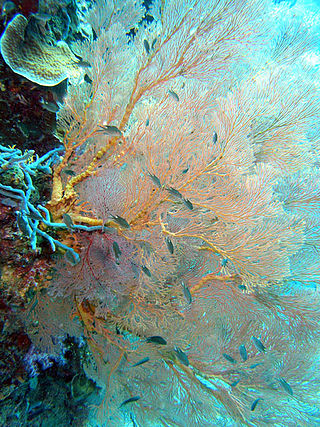
Melithaea is a genus of octocorals in the family Melithaeidae. Members of the genus are commonly known as fan corals and are found in the tropical Indo-Pacific region. The type species is Melithaea ochracea.

Plexaura is a genus of gorgonian-type octocorals in the family Plexauridae.
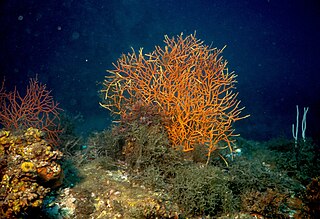
Leptogorgia is a genus of soft coral in the family Gorgoniidae. The genus has a widespread distribution with members being found in the eastern Atlantic Ocean from Western Europe to South Africa, the Mediterranean Sea, the Atlantic coasts of North and South America, the Antilles and the Pacific coast of America. Species are found in both shallow and deep waters.

Balanophyllia is a genus of solitary corals in the order of stony corals.
Lysidice is a genus of polychaete worms in the family Eunicidae.

Plexauridae is a family of marine colonial octocorals in the phylum Cnidaria. Members of this family are found in shallow tropical and subtropical seas. Many species contain symbiotic photosynthetic protists called zooxanthellae.

Leptogorgia exigua is a coral species first described by Addison Emery Verrill in 1870. Verrill initially considered this species a diminutive variant of L. cuspidata, but ultimately decided to consider L. exigua a separate species. It is native to the Pacific Ocean.

Swiftia is a genus of gorgonian-type octocorals in the family Plexauridae.

Aiptasiidae is a family of sea anemones, comprising the following genera:
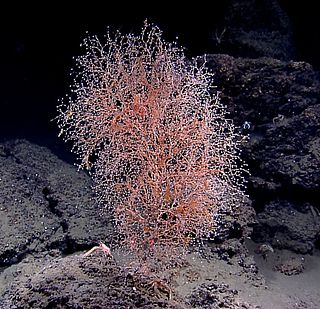
Chrysogorgia is a genus of soft corals in the family Chrysogorgiidae.

Haloclava is a genus of sea anemones in the family Haloclavidae. Members of this genus typically burrow into soft sediment.

Bugulidae is a family of bryozoans belonging to the order Cheilostomatida.

Anthogorgia is a genus of corals belonging to the family Acanthogorgiidae.

Muricella is a genus of corals belonging to the family Acanthogorgiidae.



















